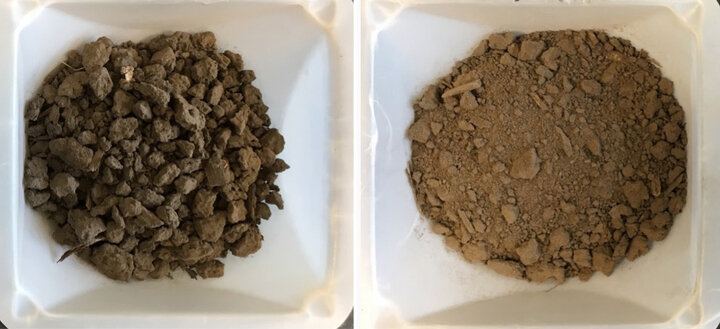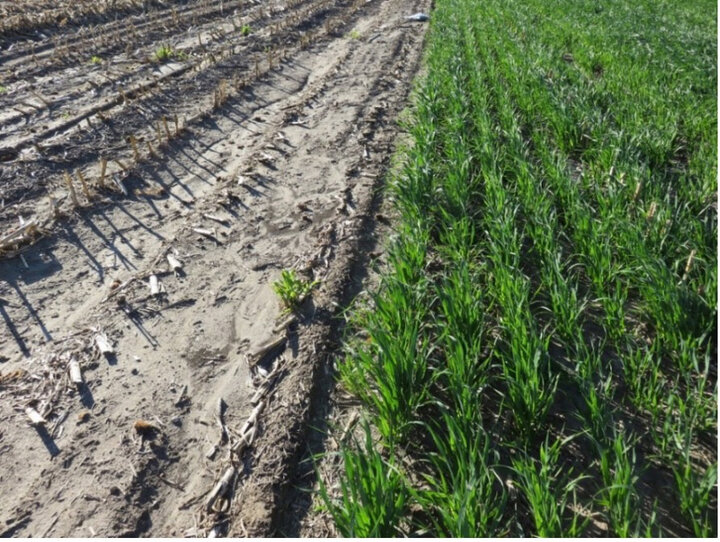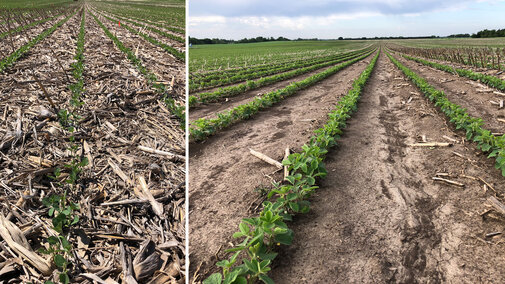| Parameter | Impact of silage compared to high moisture corn | Impact of silage with cover crop compared to silage without cover crop |
|---|---|---|
| Soil Properties | ||
| Penetration Resistance | Increased | no effect |
| Bulk Density | Increased | no effect |
| Wet Aggregate Stability | Reduced | no effect |
| Dry Aggregate Stability | Increased | no effect |
| Cumulative Infiltration | no effect | no effect |
| Water Retention | Reduced | no effect |
| Organic Matter | Reduced | no effect |
| Particulate Organic Matter | Reduced | no effect |
| Microbial Biomass | Reduced | Increased |
| Crop Yields | ||
| Soybean | no effect | no effect |
Corn harvested as corn silage is used as feed for cattle. However, harvesting corn for silage removes nearly all aboveground biomass (Figure 1), and this can be detrimental to soil. In our experiment in eastern Nebraska, compared to high moisture corn, corn silage increased soil compaction and wind and water erosion potential (expressed as dry and wet aggregate stability) while reducing water retention, organic matter fractions and microbial biomass (Figure 2). Despite degrading most near-surface soil properties, corn silage did not negatively impact subsequent soybean yields (Figure 2). Our study site was irrigated and had soils with high organic matter concentration (4.2% in the upper eight inches), possibly offsetting the potential for yield decreases under corn silage, despite the negative impact of corn silage on soil properties.
Published studies show that winter rye cover crops can offset adverse effects of corn silage harvest by increasing organic matter fractions and microbial biomass, improving soil structure, reducing erosion, scavenging N and increasing water movement in the soil (Faé et al., 2009; Krueger et al., 2011; Liesch et al, 2011; Moore et al., 2014; Ketterings et al., 2015). However, in our experiment, except for an increase in microbial biomass, the oat cover crop did not offset the negative effects of corn silage. This could be because our experiment used a winterkill cover crop of oat planted every other year, which may have limited cover crop benefits.
Field Management
This study site was established in 2015 at the Eastern Nebraska Research and Education Center near Mead, Nebraska. This experiment had two study fields (Field I and Field II), and each was 52 acres under center pivot irrigation with no-till and a corn-soybean rotation. During the corn phase, each field was cut in half, with half of the field harvested as corn silage around Sept. 1 and the other half of the field harvested as high moisture corn (32% moisture) around Sept. 15. Following corn harvest, a cover crop of Horsepower oat was drilled at 96 lbs per acre and received 40 lbs N per acre from ammonium nitrate.
How Did Corn Silage Impact Soil Properties and Crop Yields?
Compaction
Corn silage increased penetration resistance (soil compaction parameter) at both the 0-2 inches and 2-4 inches depth. However, values did not increase above what would restrict root growth. Additionally, in one field at the 2-4 inches depth, corn silage increased bulk density (compaction parameter) compared to high moisture corn. These results are expected as corn silage harvest requires additional machinery and passes in the field. Also, soil organic matter can buffer against compaction, but corn silage reduced organic matter concentration near the soil surface.

Organic Matter Fractions
For the 0-2 inches soil depth, corn silage reduced soil organic matter and particulate organic matter. Particulate organic matter is the fraction of soil organic matter that is readily accessible for microbes to use. In Field I, soil organic matter concentration was 4.6% under high moisture corn and 4.1% under corn silage. In Field II, soil organic matter was 5.5% under high moisture corn and 4.5% under corn silage. There were no significant differences in organic matter fractions at the 2-8 inches depth.
Erosion
Wind erosion potential was expressed as dry aggregate stability and water erosion potential was expressed as wet aggregate stability. Compared to high moisture corn, corn silage increased wind erosion potential, most likely due to the reduced residue cover (Figure 1 and 4). At the 0-2 inches depth, corn silage reduced wet aggregate stability, which is a parameter of soil structure. Degraded soil structure (Figure 3), represented as wet aggregate stability, can increase soil water erosion risks. Organic matter and soil microbial biomass are known to improve soil structure and aggregation by building and maintaining soil aggregates. Thus, the degradation of soil structure for the 0-2 inches soil depth could be due to the reduction in soil organic matter concentration and microbial biomass for this same depth.
Soil Water
Corn silage also reduced soil water content compared to high moisture corn, most likely due to reduced residue cover (Figure 1), thus increasing soil water evaporation. Additionally, while corn silage had no impact on water infiltration, corn silage did reduce water retention compared to high moisture corn in one of the two fields. This is most likely due to corn silage-induced reduction in soil organic matter concentration, reduction in soil porosity (increased bulk density), and reduction in soil aggregate stability, among others.
Soil Biology
Compared to high moisture corn, corn silage significantly reduced soil microbial biomass for the 0-2 and 2-4 inches soil depth. This is concerning — soil microorganisms are critical to the health of the soil as they mediate many soil functions and processes, including decomposition of plant residues, cycling of nutrients and binding soil aggregates to improve soil structure, which can improve water infiltration and resist against compaction and erosion.
Crop Yields
Despite the multiple negative impacts of corn silage on soil physical, chemical and biological properties, corn silage had no negative impact on subsequent soybean yields (Figure 2). One would expect with the large negative impacts corn silage had on soil properties that crop yields would be reduced. However, this study was conducted on deep loess soils of eastern Nebraska, which are known for their inherent fertility and high soil organic matter concentration. Therefore, the soil at this study site may have prevented yield losses following corn silage. This study site was also irrigated, so despite the reduced residue cover under corn silage increasing soil evaporation and leading to soil water loss, irrigation probably offset these losses and potential yield reductions. Other soil types and management practices may show different results under corn silage harvest, but because this study site is irrigated and has overall high soil organic matter content, we believe these factors may have offset any potential reductions in yield due to corn silage.
Did the Cover Crop Offset the Negative Impacts of Corn Silage?
The oat cover crop did little to overcome the negative impacts of corn silage; however, corn silage with cover crop had greater microbial biomass than corn silage without cover crop (Figure 2). This is most likely due to the increased above and belowground cover crop biomass to support soil microorganisms. This is promising as soil microorganisms mediate many processes and functions in the soil, as discussed above. Additionally, from observation, the oat cover crop appeared to prevent erosion during its growth (Figure 4). We believe our study found little to no impact of the oat cover crop because it was only planted every other year and is winterkilled. Thus, winterkilled cover crops are unlikely to produce biomass similar to cover crops that overwinter. Previous studies that found benefits of cover cropping with corn silage used winter rye — a cover crop that overwinters. However, an oat cover crop was chosen for our study for high biomass production in the fall with no need to terminate it in the spring.

Should Cover Crops Be Used with Corn Silage?
- Our study found oat cover crop after corn silage harvest increased microbial biomass but did not impact other soil properties. However, other research using a winter rye cover crop after corn silage found that rye can offset damaging impacts of corn silage. In our experiment, the oat cover crop was winterkilled, possibly limiting the beneficial impact of the cover crop to offset corn silage impacts.
- Based on visual observations, the oat cover crop did reduce erosion during its growth period by covering and protecting the soil surface (Figure 4), although changes in soil aggregate stability were not significant.
- The choice of cover crop is critical and must fit the goals of your farming system, but longer live cover crop growth periods — like with cover crops that overwinter — can be beneficial.
- The silt loam loess soils of eastern Nebraska are highly erodible, as indicated in this study (Figure 1, 2 and 4). Also, a recent study of the U.S. Corn Belt, including eastern Nebraska, found that we have lost around 35% of our topsoil, which results in around $2.8 billion dollars of economic loss annually (Thaler et al., 2021). Therefore, with corn silage harvest leaving the soil bare of residue cover (Figure 1 and 4), the hidden costs of soil erosion cannot be understated. Thus, a cover crop following corn silage can be recommended to ameliorate the negative effects of corn silage. Specifically, a cover crop that overwinters can protect the soil in the spring when winds and rainfall amount are high before main crops are established.
Acknowledgements
We thank Nebraska Environmental Trust and the USDA SARE for their funding of this research. Also, we thank Kallie Calus, McKenna Brinton, Benjamin Hansen, Kristen Ulmer, Zachary Carlson and Fred Hilscher for their work on this research. Additionally, we thank Mark Schroeder and team at the Eastern Nebraska Research and Education Center for field management, Husker Genetics for acquiring and planting oats, Elizabeth Jeske for soil microbial analysis, and all undergraduate and graduate students assisting with field work.
References
Faé, G. S., Sulc, R. M., Barker, D. J., Dick, R. K., & Eastridge M. L. (2009). Integrating winter annual forages into a no-till corn silage system. Agron. J., 101: 1286-1289. doi:10.2134/agronj2009.0144.
Ketterings, Q. M., Swink, S. N., Duiker, S. W., Czymmek, K. J., Beegle, D. B., & Cox, W. J. (2015). Integrating cover crops for nitrogen management in corn systems on Northeastern U.S. dairies. Agron. J., 107: 1365-1376. doi:10.2134/agronj14.0385.
Krueger, E. S., Ochsner, T. E., Porter, P. M., and Baker, J. M. (2011). Winter rye cover crop management influences on soil water, soil nitrate, and corn development. Agron. J., 103: 316-323. doi:10.2134/agronj2010.0327
Liesch, A. M., Krueger, E. S., & Ochsner, T. E. (2011). Soil structure and physical properties under rye-corn silage double-cropping systems. Soil Sci. Soc. Am. J., 75: 1307-1314. doi:10.2136/sssaj2010.0292.
Moore, E. B., Wiedenhoeft, M. H., Kaspar, T. C., & Cambardella, C. A. (2014). Rye cover crop effects on soil quality in no-till corn silage-soybean cropping systems. Soil Sci. Soc. Am. J., 78: 968-976. doi:10.2136/sssaj2013.09.0401.
Thaler, E. A., Larsen, I. J., Yu, Q. 2021. The extent of soil loss across the US Corn Belt. Proceedings of the National Academy of Sciences, 118: 1-18. https://doi.org/10.1073/pnas.1922375118
Additional Resources
Planting cover crops after silage offers several benefits (https://cropwatch.unl.edu/2017/planting-cover-crops-after-silage-offers-several-benefits)
Harvesting crop residues NebGuide (https://extensionpublications.unl.edu/assets/pdf/g1846.pdf)
Consider nutrient removal and ground cover costs when harvesting corn for silage (https://cropwatch.unl.edu/consider-nutrient-removal-and-ground-cover-costs-when-harvesting-corn-silage-aug-10-2012)

